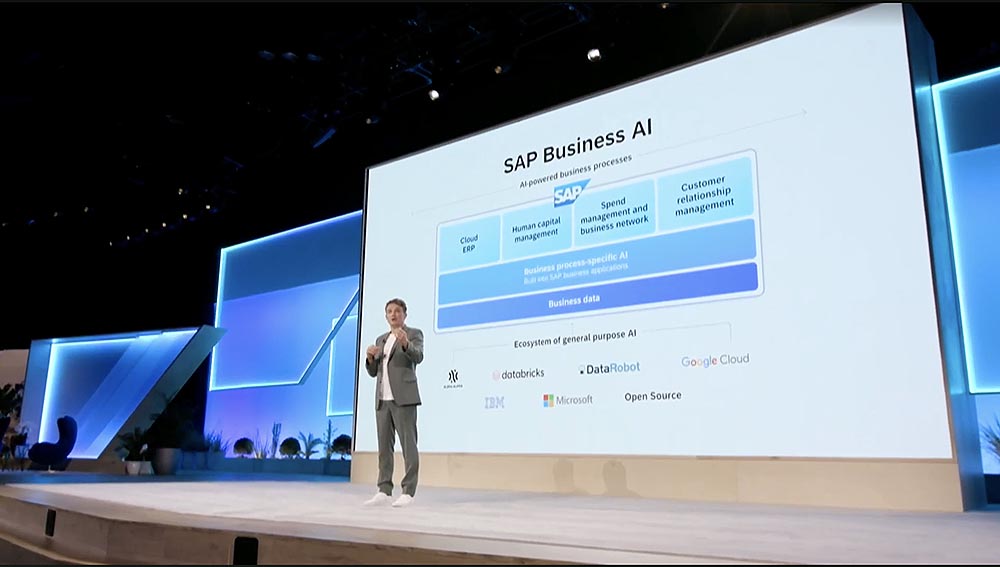Disclaimer: these are my own thoughts, not those of my employer. I’ve noted the things that I took away as new, interesting, or different. BUT all that is necessarily subjective, and there was a lot more going on than I have mentioned here. In particular, see the official Sapphire News Guide.
Unsurprisingly, one of the first big topics was the rise of Artificial Intelligence. SAP has been embedding AI into lots of different areas for many years now, in areas like logistics, finance, travel receipts, etc. A lot of this is already taken for granted because “it just works”. But of course the the latest technology changes mean new business opportunities, and the main SAP AI product page has been updated to include new AI application examples and messaging.
So why would you be interested in using SAP’s Business AI technology? Well, because it’s “Built for business”
- Built into your processes: Make agile decisions, unlock valuable insights, and automate tasks with AI built into your end-to-end business processes.
- Relevant to you: Experience AI that is trained on your industry and company data, driven by SAP process expertise, and accessible in the solutions you use daily.
- Trusted and responsible AI: Run responsible AI built on leading ethics and data privacy standards while maintaining full governance and lifecycle management across your entire organization.
Or as Microsoft CEO Satya Nadella put it: “Business context is important”! — and SAP is all about business data and end-to-end business process workflows. For example, Microsoft is a huge user of SAP SuccessFactors, and the keynote included a demonstration of how HR professionals could leverage Microsoft Copilot with relevant, reliable data from SAP systems.
A new Generative AI Roadmap page and a more detailed blog post give some examples of how generative AI can benefit existing business workflows, including helping deal with freight documentation (in SAP Transportation Management), write job descriptions (in SAP SuccessFactors Recruiting), or find best-matching processes (in SAP Signavio Process Transformation Suite).
I was particularly interested in two of them:
- SAP Analytics Cloud’s new Just Ask feature, powered by the AskData technology, acquired by SAP last year. This is an extension/replacement of the existing Search-to-Insight functionality. These kinds of interfaces are set to completely transform how people access data, and there have been some amazing examples of people using ChatGPT with Code Interpreter, to do things that no analytics software has ever before imagined being able to do, such as “take this data file of lighthouses and turn it into create a .gif file that animates the lighthouses twinkling on a map”. It’s clear that it’s a whole new disruptive world out there for analytics. No matter what happens to AI engines, SAP’s strengths will be on providing the right data and making it’s actually used as part of productive, compliant, reliable business workflows.
- A new SAP Digital Assistant: “Currently in the alpha stage, SAP’s Digital Assistant for CX app uses generative AI to provide holistic insights, create recommendations, and generate personalized content so you can offer a better customer experience.” It’s clear that these kind of interfaces will be a required part of any enterprise application software, and it’s only a question of time before you can chat with and pilot any aspect of your business workflows with digital assistants.
The keynote emphasized what SAP has always focused on: pragmatic, real-world optimization of business processes, leveraging the latest new technologies. This included a tour of the farm-to-consume Sapphire showcase with Unilever, and the vaccine production supply chain at Pfizer using the SAP Business Network.
New SAP CFO Dominik Asam talked to Schneider Electric about making sustainability actionable, and the challenges of carbon accounting, becoming more detailed and proactive about providing valuable data to business leaders and along the supply chain. SAP is supporting these new initiatives with a set of new solutions detailed in the SAP News Guide. The solutions help bring carbon accounting directly into transaction-level systems — for example, the SAP Sustainability Data Exchange application helps gather actual carbon data directly from their suppliers, rather than having to estimate emissions.
THE big problem with any use of artificial intelligence is getting the right data in the first place. By the very nature of ERP, SAP systems typically contain the most important, valuable, and reliable data in the organization. But accessing it is hard. SAP had already announced a new “Business Data Fabric” solution called SAP Datasphere. That involved strategic partners such as Databricks, Collibra, Confluence, and Data Robot, and was recently extended to include Google’s data solutions. Google’s Thomas Kurian was on stage discussing the new opportunities.
Christian opened up the discussion of RISE with SAP with a cautionary tale about the dangers of doing lift-and-shift moves to the cloud without rethinking and standardizing business processes. He emphasized the power of SAP Signavio now natively integrated into the SAP product portfolio. It can analyze your systems in minutes, identify bottlenecks and opportunities, then recommend solutions from the new Business Accelerator Hub and leveraging SAP Build — we’re well on the way to “automating automation”.





